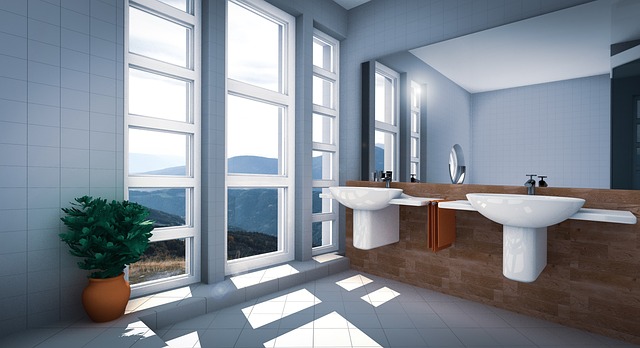Room layout modeling, leveraging digital blueprints and 3D software, is a vital interior design tool that enables designers to quickly visualize and manipulate virtual spaces, explore multiple concepts, and address circulation or furniture placement issues early on. This process enhances client communication through immersive visualizations, ensuring expectations are met. Material selection for room layout modeling considers aesthetics, functionality, and sustainability, with finishes like matte, satin, or gloss affecting reflectivity and maintenance needs. Finish simulations using advanced technologies allow designers to create realistic renderings and 3D models, streamlining decision-making and ensuring final products meet aesthetic and practical expectations.
“Unleash the power of visual design tools with our comprehensive guide on material and finish simulations. In today’s digital age, informed design decisions are paramount, especially when it comes to understanding complex room layouts. This article navigates the process of room layout modeling, offering insights into its basics and benefits. We explore an extensive guide on choosing materials, followed by a deep dive into finish simulations for enhanced visual aesthetics. Learn how combining these simulations can revolutionize your design process.”
Understanding Room Layout Modeling: The Basics and Benefits
Room layout modeling is a fundamental process in interior design, allowing designers to visualize and manipulate virtual representations of spaces. It involves creating a digital blueprint that accurately reflects the dimensions, shapes, and characteristics of a room or building. By utilizing 3D modeling software, designers can craft detailed models, incorporating furniture arrangements, material choices, and finish selections. This technology offers numerous advantages for informed design decisions.
The benefits are vast; it enables designers to explore various design concepts quickly, providing a realistic preview of how a space will look and feel before construction or renovation begins. It aids in identifying potential issues with floor plans, such as circulation problems or furniture placement constraints, allowing for iterative improvements. Additionally, room layout modeling facilitates client communication, offering a clear and immersive understanding of the proposed design. This interactive process ensures clients’ expectations are met, fostering better collaboration and satisfaction throughout the design journey.
Choosing the Right Materials: A Comprehensive Guide
Choosing the right materials is a pivotal step in design, influencing aesthetics, functionality, and sustainability. It begins with understanding the purpose and atmosphere of each space through room layout modeling. For instance, natural stones like marble or granite exude luxury and durability, making them ideal for high-traffic areas like kitchens or entryways. In contrast, soft fabrics and wood offer warmth and comfort, suitable for cozy living rooms or bedrooms.
When selecting materials, consider factors such as texture, color, and finish. Textured surfaces add depth and visual interest, while neutral colors provide versatility, allowing easy adaptation to changing trends. Finishes like matte, satin, or gloss impact reflectivity and maintenance requirements. A well-informed material choice not only enhances the design but also ensures longevity and value retention of the space in your room layout modeling.
Finish Simulations: Visualizing and Enhancing Design Aesthetics
Finish simulations play a pivotal role in the design process by offering a visual glimpse into the final aesthetic of a space. Through advanced technologies, designers can now create realistic renderings and 3D models that showcase the look and feel of different finishes, materials, and textures. This visual enhancement allows for informed decisions regarding room layout modeling, enabling clients and professionals to envision the completed project before construction begins.
By simulating various finishes, from sleek modern surfaces to rustic natural materials, designers can explore diverse design directions. These simulations not only help in material selection but also guide decisions on color palettes, lighting, and overall ambiance. With such powerful tools at their disposal, the design process becomes more efficient, ensuring that the final product aligns with aesthetic expectations while adhering to practical considerations.
Informed Design Decisions: Combining Layout and Finish Simulations for Success
Informed design decisions are pivotal in transforming concepts into functional, aesthetically pleasing spaces. To achieve this, designers increasingly rely on a combination of room layout modeling and finish simulations. The former allows for the precise planning of spatial arrangements, while the latter brings these designs to life by visualizing textures, colors, and materials.
By integrating these two powerful tools, designers can anticipate the final outcome with greater accuracy. Finish simulations, powered by advanced rendering technologies, offer a realistic preview of how different materials and finishes will interact within a given layout. This proactive approach enables designers to make adjustments early in the process, ensuring that both the functionality and aesthetics of the space meet client expectations.
Room layout modeling and material simulations are powerful tools that enable designers to make informed decisions, ensuring aesthetic appeal and functional practicality. By combining these techniques, professionals can create immersive visualizations, predict real-world outcomes, and enhance client satisfaction. This comprehensive guide has underscored the significance of room layout modeling, material choices, and finish simulations in the design process, demonstrating how these elements collectively contribute to successful project outcomes.
